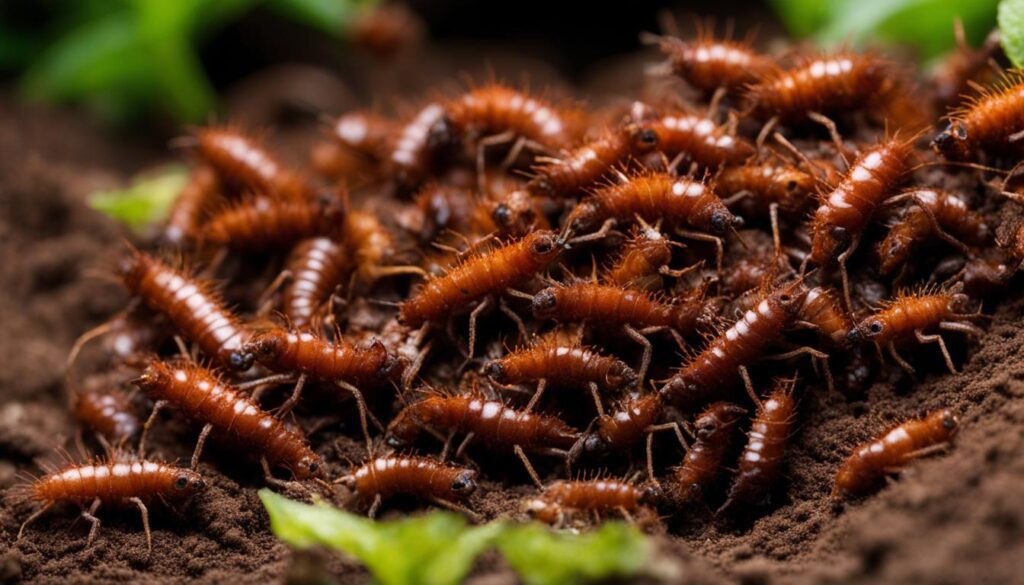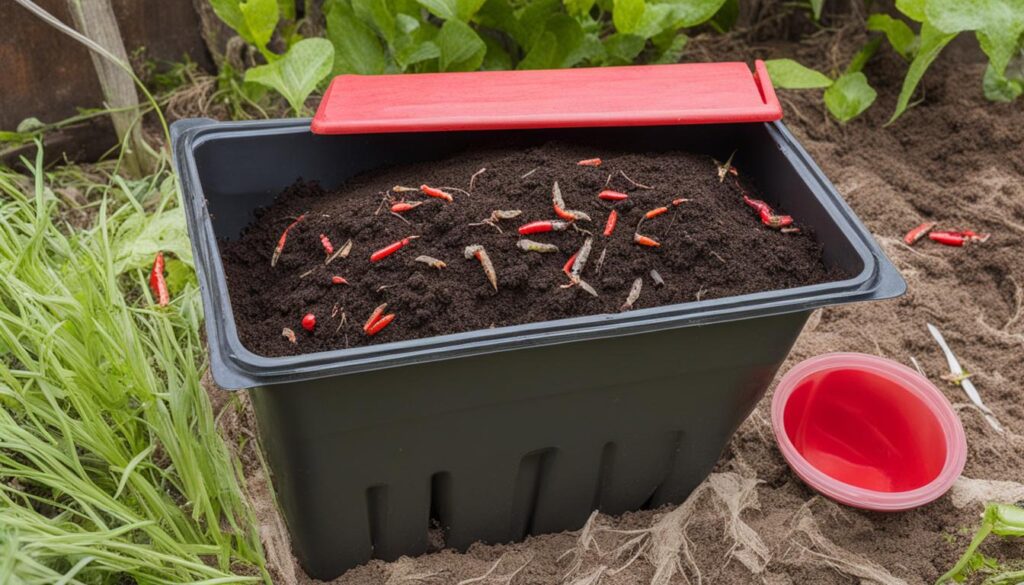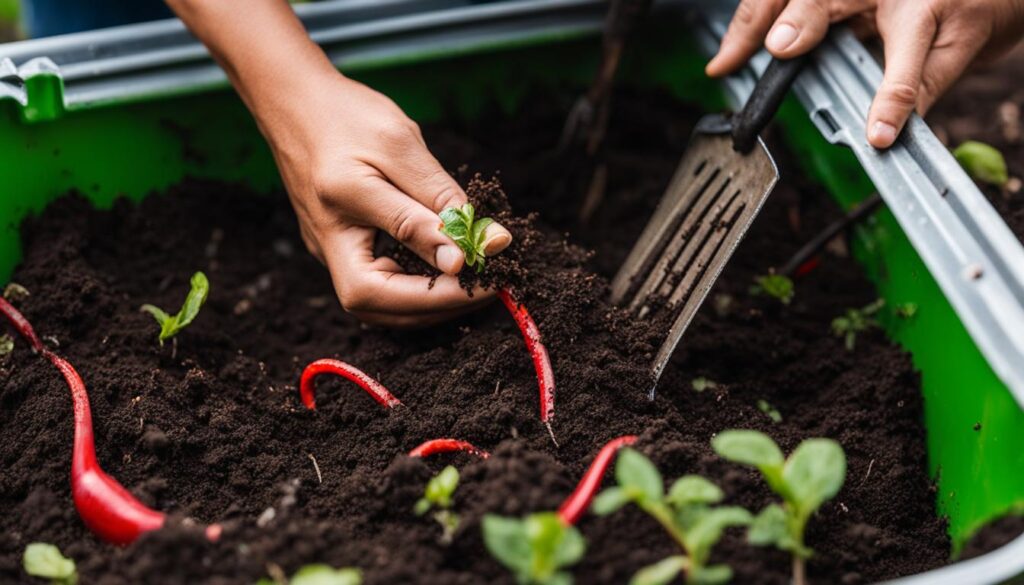Composting with worms, also known as vermiculture, is a simple and effective way to turn organic waste into nutrient-rich soil. By starting your own worm farm, you can contribute to reducing landfill waste, create your own organic fertilizer, and even generate a potential source of income. In this comprehensive guide, we will walk you through the basics of starting a worm farm, including choosing the right worms, setting up a worm bin, and providing the right conditions for your worms to thrive. Get ready to dig into the wonderful world of worm composting!
Key Takeaways:
- Composting with worms, or vermiculture, is an eco-friendly way to convert organic waste into nutrient-rich soil.
- Starting your own worm farm can help reduce landfill waste, create organic fertilizer, and potentially generate income.
- Choosing the right worms, setting up a proper worm bin, and providing the right conditions are essential for a successful worm farm.
- Feeding your compost worms the right types of food and maintaining proper moisture levels are crucial for their health.
- Expanding your worm farm into a business venture can involve selling worm castings and breeding worms for vermicomposting or fishing bait.
What is Worm Composting?
Worm composting, or vermiculture, is the process of using live compost worms to break down organic waste into nutrient-rich material called worm castings or vermicompost. This natural process has been evolving for millions of years and involves worms consuming organic matter and excreting a highly beneficial substance that helps plants grow stronger and healthier. Worm castings are highly valued by organic farmers and gardeners as they provide essential nutrients to plants, improve soil structure, and promote microbial activity.
If we take a closer look at the process of worm composting, it starts with the introduction of organic waste into a worm bin. This can include kitchen scraps like vegetable peelings, coffee grounds, and eggshells, as well as yard waste such as leaves and grass clippings. The worms then consume this organic material, breaking it down through their digestive process. As the worms digest the waste, they excrete castings, which are rich in nutrients and microorganisms.
The resulting worm castings are a valuable resource for gardeners and farmers. They can be used as a natural and organic fertilizer to enrich soil, improve plant growth, and enhance overall soil health. Worm castings provide a wide range of nutrients, including nitrogen, phosphorus, potassium, and trace minerals. They also contribute to soil structure, water retention, and the growth of beneficial soil microorganisms.
| Benefits of Worm Composting |
|---|
| Converts organic waste into nutrient-rich compost |
| Reduces landfill waste and greenhouse gas emissions |
| Improves soil structure and fertility |
| Promotes the growth of healthy plants |
| Reduces the need for chemical fertilizers |
By engaging in worm composting, individuals can contribute to a more sustainable and eco-friendly way of managing organic waste. It provides an opportunity to recycle kitchen scraps and yard waste, reducing the amount of waste that ends up in landfills. Additionally, worm composting offers a natural alternative to synthetic fertilizers, promoting healthier soil and plants without the use of harmful chemicals.

Worm castings are like nature’s gold for gardeners. They contain all the essential nutrients plants need to grow and thrive, and they improve soil health in the process. Plus, you get the satisfaction of knowing that you’re reducing waste and taking a step towards a more sustainable future. It’s a win-win all around.” – Gardening enthusiast
Choosing the Right Compost Worms
When starting a worm farm, it’s important to choose the right type of worms for composting. The most common and recommended worms for worm composting are red wigglers (Eisenia fetida) and nightcrawlers (African or European). Red wigglers are voracious eaters, adapting well to various conditions and consuming large amounts of organic waste. Nightcrawlers, on the other hand, are larger and burrow deeper into the soil, making them suitable for vermicomposting in outdoor bins. Consider the specific needs of your setup and choose the worms that best fit your requirements and environment.
Different Types of Compost Worms
There are three primary types of compost worms commonly used in vermiculture:
- Red Wigglers (Eisenia fetida): These worms are highly adaptable and thrive in a wide range of environments. They are efficient decomposers and can consume large quantities of organic waste.
- Nightcrawlers: Nightcrawlers are larger worms that prefer to burrow deep into the soil. They are commonly used in outdoor vermicomposting systems and are known for their ability to break down organic matter efficiently.
- Perionyx excavatus: Also known as the Indian Blue worm, these worms are well-suited for composting and can tolerate a wide range of temperatures. They are particularly effective at breaking down fibrous materials.
When choosing the right compost worms for your worm farm, consider factors such as the size of your compost bin, the amount of organic waste you will be processing, and the environmental conditions in your area.

Comparing Red Wigglers and Nightcrawlers
| Red Wigglers (Eisenia fetida) | Nightcrawlers |
|---|---|
| Small size, ideal for indoor vermicomposting bins | Larger size, better suited for outdoor vermicomposting |
| Adapt well to different conditions | Prefer cool and moist environments |
| Consume large amounts of organic waste | Less voracious eaters, slower decomposition |
| Reproduce quickly | Slower reproduction rate |
| Ideal for small-scale vermicomposting | Suited for larger vermicomposting operations |
Both red wigglers and nightcrawlers have their advantages and are suitable for different types of worm composting setups. Consider your specific needs and requirements to make an informed decision.
Setting Up Your Worm Composting Bin
Once you have chosen the right compost worms for your worm farm, it’s time to set up a suitable worm composting bin. There are a few options available, depending on your needs and preferences. You can either purchase a pre-made worm bin or build your own using a plastic storage bin. Regardless of the type of bin you choose, there are a few key components to consider.
First, you’ll need proper worm bedding to create a comfortable environment for your worms. A combination of compost or manure, shredded newspaper or cardboard, and topsoil or peat moss works well as bedding. This mixture provides the worms with a source of food and a place to burrow and reproduce.
Next, it’s essential to add a cover to your worm bin. This cover helps maintain the right moisture levels and airflow within the bin. It can be as simple as a piece of breathable cloth or a lid with holes to allow for ventilation. The cover also helps keep unwanted pests out of the bin.
Remember that the size of your worm composting bin will depend on the number of worms you plan to house and the amount of organic waste you generate. Make sure to choose a bin that provides enough space for your worms to thrive and reproduce. With the right setup, your worms will be well on their way to turning your organic waste into nutrient-rich worm castings.

Table: Pros and Cons of Different Worm Bin Options
| Worm Bin Option | Pros | Cons |
|---|---|---|
| Purchasing a pre-made worm bin | – Ready to use out of the box – Designed specifically for worm composting – Usually comes with detailed instructions | – Can be more expensive than building your own – Limited customization options |
| Building your own using a plastic storage bin | – More affordable option – Allows for customization and flexibility in size and design – Easy to find and purchase materials | – Requires manual construction – May take more time and effort to set up |
Feeding Your Compost Worms
Feeding your compost worms with the right types of food is essential for their health and the success of your worm farm. Compost worms thrive on a variety of organic kitchen waste, including vegetables, fruits, coffee grounds, and shredded cardboard. These materials provide the necessary nutrients for the worms to break down and transform into nutrient-rich worm castings. However, it’s important to be mindful of what you feed them to maintain a balanced diet.
Here are some guidelines for feeding your compost worms:
- Avoid feeding them meat, dairy products, oily food, citrus fruits, and anything that is high in salt or sugar.
- Cut the food into small pieces to make it easier for the worms to consume.
- Always bury the food in the bedding to avoid attracting pests.
Remember, worms eat approximately 25-50% of their body weight per day, so be mindful of the quantity you provide to prevent overfeeding. If you notice that the food is rotting or there are unpleasant odors in your worm bin, you may be feeding them too much. Adjust the feeding schedule accordingly to maintain a healthy environment for your worms.
By providing your compost worms with a balanced diet of organic kitchen waste, you’ll not only keep them happy and healthy, but also ensure they produce high-quality worm castings that can be used as a nutrient-rich fertilizer for your plants.
Table: Foods Suitable for Compost Worms
| Food | Recommended | Not Recommended |
|---|---|---|
| Vegetables | ✓ | ✗ |
| Fruits | ✓ | ✗ |
| Coffee grounds | ✓ | ✗ |
| Shredded cardboard | ✓ | ✗ |
| Meat | ✗ | ✓ |
| Dairy products | ✗ | ✓ |
| Oily food | ✗ | ✓ |
| Citrus fruits | ✗ | ✓ |
| Salted or sugary food | ✗ | ✓ |

Maintaining Your Worm Farm
Proper maintenance is crucial for the success of your worm farm. By following a few simple care practices, you can ensure that your worms thrive and continue to produce high-quality vermicompost. Here are some key aspects to consider when maintaining your worm farm:
1. Worm Bin Moisture
Moisture levels in your worm bin play a critical role in the well-being of your worms. The bedding should be kept moist, similar to a wrung-out sponge, to provide a comfortable environment for the worms. However, it’s important to avoid overwatering as it can lead to anaerobic conditions and the growth of harmful bacteria. Regularly check the moisture levels and add water if necessary, or add dry bedding materials if the bin becomes too wet.
2. Worm Population
Monitoring the population of your compost worms is essential for maintaining a healthy worm farm. Keep an eye on the number of worms in your bin and evaluate if it’s increasing or decreasing over time. If the population begins to decline, it may be an indication of unfavorable conditions or insufficient food supply. Adjust the feeding schedule and environmental factors accordingly to support the growth and reproduction of your worms.
3. Worm Composting Checklist
Following a worm composting checklist can help you stay organized and ensure that all necessary tasks are completed. Your checklist may include items such as checking and adjusting moisture levels, feeding the worms regularly, removing any uneaten food or waste, and harvesting worm castings when they are ready. Establishing a routine and adhering to a checklist can promote consistency and help you maintain a healthy and productive worm farm.
| Worm Farm Checklist |
|---|
| Check and adjust moisture levels |
| Feed worms regularly |
| Remove uneaten food or waste |
| Harvest worm castings |
| Monitor worm population |
Maintaining a worm farm requires consistency and attention to detail. By properly managing moisture levels, monitoring worm populations, and following a checklist, you can ensure that your worm farm remains healthy and productive. With time and care, you will be rewarded with nutrient-rich vermicompost and a thriving worm community.

Expanding Your Worm Farm Business
Once you have established a successful worm farm, you may consider expanding your operation and turning it into a profitable business venture. There are several opportunities available for you to explore in the worm farming industry.
Breeding Worms
Breeding worms can be a lucrative aspect of your worm farm business. By increasing your worm population, you can ensure a consistent supply of high-quality worm castings and live worms for sale. Implement breeding strategies and techniques to optimize the reproductive capacity of your worms and expand your inventory.
Table:
| Worm Breeding Techniques | Description |
|---|---|
| Bedding Selection | Choose appropriate bedding materials that create a favorable environment for worm reproduction. |
| Proper Nutrition | Provide a balanced diet for your worms to promote healthy reproduction and growth. |
| Separation of Clusters | Separate clusters of cocoons to prevent overcrowding and ensure optimal conditions for hatching. |
| Optimal Temperature | Maintain the ideal temperature range for worm breeding, typically between 70-80 degrees Fahrenheit. |
Identifying Potential Markets
Conduct market research to identify potential customers for your vermicompost and live worms. Farmers, greengrocers, gardeners, and fishing enthusiasts are just a few examples of target markets that may benefit from your products. Understand their unique needs and preferences to tailor your offerings and establish long-lasting relationships.
Table:
| Potential Markets | Description |
|---|---|
| Organic Farmers | Offer high-quality vermicompost as an organic fertilizer alternative to chemical-based options. |
| Garden Centers | Collaborate with local garden centers to provide customers with a sustainable and nutrient-rich soil amendment. |
| Bait Shops | Supply live worms to fishing enthusiasts who prefer using organic bait. |
Sales and Marketing Strategies
To promote your worm farm business and attract potential customers, develop effective sales and marketing strategies. Establish an online presence through a website and social media platforms to showcase your products and share educational content about the benefits of vermiculture. Attend local farmers’ markets, gardening events, and trade shows to engage with your target audience directly.
- Create engaging and informative product descriptions
- Offer competitive pricing and discounts for bulk orders
- Provide excellent customer service and support
- Utilize word-of-mouth marketing through satisfied customers
By expanding your worm farm business and tapping into potential markets, you can maximize the profitability of your venture while promoting the benefits of vermiculture and sustainable agriculture.
Conclusion
Starting your own worm farm is a sustainable and rewarding way to contribute to the environment. Through vermiculture and composting with worms, you can actively reduce waste and create nutrient-rich soil for your plants. By harnessing the power of these humble creatures, you can produce organic fertilizer that promotes healthy growth and sustainability in your garden.
Embracing the art of worm farming allows you to play a pivotal role in the ecosystem. As you recycle organic materials and transform them into valuable worm castings, you’re diverting waste from landfills and minimizing your carbon footprint. This sustainable practice not only benefits your own garden but also contributes to a more environmentally conscious future.
With the right knowledge, setup, and dedication, your worm farm can truly flourish. Take the time to choose the appropriate worms, create an optimal worm composting bin, and diligently maintain the conditions necessary for your worms to thrive. By prioritizing their well-being, you’ll be rewarded with an abundant supply of organic fertilizer and a harmonious relationship with nature.
FAQ
What is worm composting?
Worm composting, also known as vermiculture, is the process of using live compost worms to break down organic waste into nutrient-rich material called worm castings or vermicompost.
How do I choose the right compost worms?
The most common and recommended worms for worm composting are red wigglers (Eisenia fetida) and nightcrawlers (African or European). Consider the specific needs of your setup and choose the worms that best fit your requirements and environment.
How do I set up a worm composting bin?
There are various options available, such as purchasing a pre-made worm bin or building your own using a plastic storage bin. The size and design of the bin will depend on the number of worms you plan to house and the amount of organic waste you generate. Additionally, you will need proper worm bedding and a cover for the bin to maintain proper moisture levels and airflow.
What should I feed my compost worms?
Compost worms thrive on organic kitchen waste such as vegetables, fruits, coffee grounds, and shredded cardboard. Avoid feeding them meat, dairy products, oily food, citrus fruits, and anything high in salt or sugar. Remember to cut the food into small pieces and bury it in the bedding to avoid attracting pests.
How do I maintain my worm farm?
Regular maintenance is key. Check the moisture levels in your worm bin regularly, adjust the feeding schedule based on the growth of your worm population, and monitor the temperature of your worm farm. Follow a worm composting care checklist to stay on top of essential tasks and maintain a healthy environment for your worms.
How can I expand my worm farm into a business?
Conduct market research to identify potential customers, such as farmers, greengrocers, gardeners, and fishing enthusiasts. Worm castings can be sold as organic fertilizer or soil amendment, while live worms can be sold for vermicomposting or fishing bait. Consider expanding your worm population through breeding and build relationships with local businesses to establish a successful worm farm business.